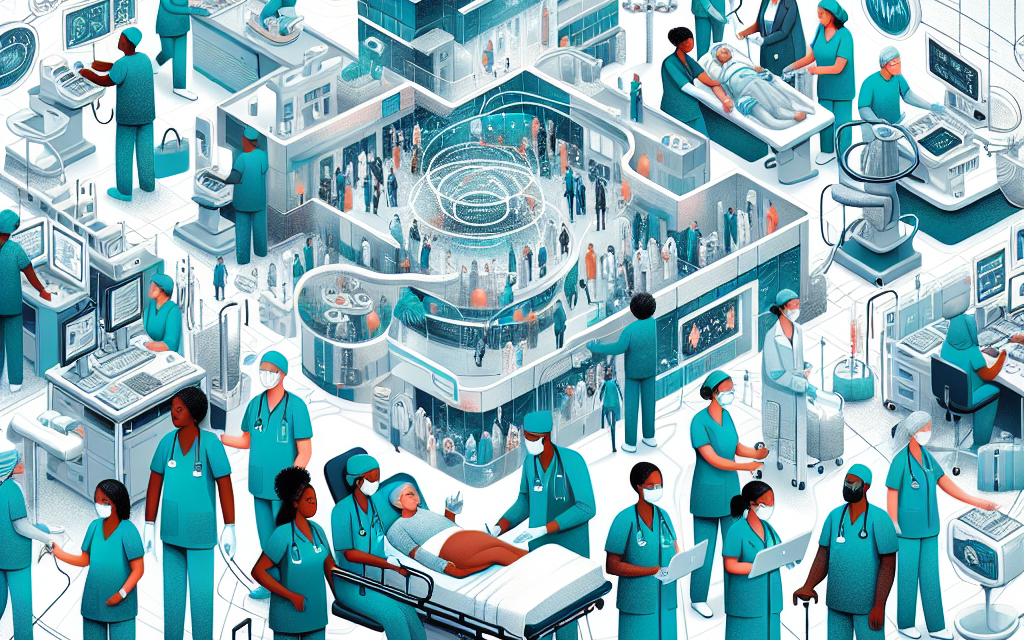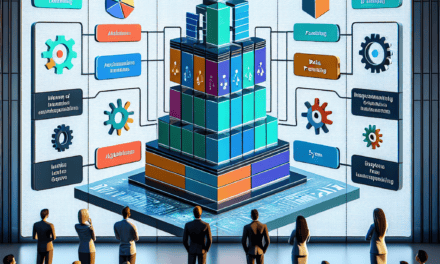Safeguarding Healthcare Infrastructure: Ensuring Continuous Care Delivery
In an era where healthcare systems are increasingly strained by rising demand, technological advancements, and unexpected crises, safeguarding healthcare infrastructure has become paramount. The ability to ensure continuous care delivery is not just a matter of convenience; it is a critical component of public health and safety. This article delves into the multifaceted aspects of safeguarding healthcare infrastructure, exploring the challenges, strategies, and innovations that can help maintain uninterrupted healthcare services.
1. Understanding Healthcare Infrastructure
Healthcare infrastructure encompasses the physical and organizational structures needed for the delivery of healthcare services. This includes hospitals, clinics, laboratories, and the technology that supports them. Understanding the components of healthcare infrastructure is essential for identifying vulnerabilities and implementing effective safeguards.
1.1 Components of Healthcare Infrastructure
The healthcare infrastructure can be broadly categorized into several components:
- Physical Facilities: Hospitals, outpatient clinics, long-term care facilities, and emergency care centers.
- Medical Equipment: Diagnostic machines, surgical instruments, and patient monitoring systems.
- Information Technology: Electronic health records (EHR), telemedicine platforms, and data management systems.
- Human Resources: Healthcare professionals, administrative staff, and support personnel.
- Supply Chain: Pharmaceuticals, medical supplies, and equipment logistics.
Each of these components plays a vital role in the overall functionality of healthcare systems. Disruptions in any one area can lead to significant challenges in care delivery.
1.2 The Importance of Resilience
Resilience in healthcare infrastructure refers to the ability to prepare for, respond to, and recover from disruptions. This resilience is crucial for maintaining continuous care delivery, especially during crises such as natural disasters, pandemics, or cyberattacks. A resilient healthcare system can adapt to changing circumstances while ensuring that patients receive the care they need.
1.3 Current Challenges
Healthcare infrastructure faces numerous challenges that threaten its resilience:
- Funding Constraints: Many healthcare systems operate under tight budgets, limiting their ability to invest in necessary upgrades and maintenance.
- Technological Vulnerabilities: As healthcare becomes more digitized, the risk of cyberattacks increases, potentially compromising patient data and care delivery.
- Workforce Shortages: A lack of qualified healthcare professionals can strain existing resources and impact patient care.
- Natural Disasters: Events such as hurricanes, earthquakes, and floods can damage facilities and disrupt services.
- Public Health Crises: Pandemics like COVID-19 have exposed weaknesses in healthcare systems worldwide, highlighting the need for robust emergency preparedness.
2. Strategies for Safeguarding Healthcare Infrastructure
To ensure continuous care delivery, healthcare organizations must adopt comprehensive strategies that address the vulnerabilities identified in the previous section. These strategies can be categorized into several key areas:
2.1 Investment in Technology
Investing in advanced technology is crucial for enhancing the resilience of healthcare infrastructure. This includes:
- Telemedicine: Expanding telehealth services allows patients to receive care remotely, reducing the burden on physical facilities.
- Data Security: Implementing robust cybersecurity measures protects sensitive patient information and ensures the integrity of healthcare systems.
- Interoperability: Ensuring that different healthcare systems can communicate effectively improves care coordination and patient outcomes.
For example, during the COVID-19 pandemic, many healthcare organizations rapidly adopted telemedicine solutions, which allowed them to continue providing care while minimizing the risk of virus transmission. According to a report by McKinsey, telehealth utilization increased by 38 times from the pre-pandemic baseline, demonstrating the potential of technology to safeguard care delivery.
2.2 Strengthening Supply Chains
A resilient supply chain is essential for ensuring that healthcare facilities have the necessary resources to operate effectively. Strategies for strengthening supply chains include:
- Diversifying Suppliers: Relying on multiple suppliers reduces the risk of shortages and disruptions.
- Inventory Management: Implementing just-in-time inventory systems can help manage resources more efficiently while ensuring that critical supplies are always available.
- Local Sourcing: Partnering with local suppliers can reduce transportation times and costs, enhancing responsiveness during emergencies.
During the early stages of the COVID-19 pandemic, many healthcare systems faced severe shortages of personal protective equipment (PPE) and ventilators. Organizations that had diversified their supply chains were better positioned to respond to these challenges, demonstrating the importance of proactive supply chain management.
2.3 Workforce Development
A well-trained and adequately staffed workforce is vital for maintaining continuous care delivery. Strategies for workforce development include:
- Training Programs: Ongoing education and training ensure that healthcare professionals are equipped with the latest knowledge and skills.
- Recruitment Initiatives: Attracting new talent through incentives and partnerships with educational institutions can help address workforce shortages.
- Employee Well-being: Supporting the mental and physical well-being of healthcare workers can reduce burnout and improve retention rates.
For instance, during the COVID-19 pandemic, many healthcare organizations implemented mental health support programs for their staff, recognizing the immense stress and challenges they faced. These initiatives not only helped retain staff but also improved overall morale and patient care quality.
2.4 Emergency Preparedness Planning
Effective emergency preparedness planning is essential for safeguarding healthcare infrastructure. Key components of a robust emergency preparedness plan include:
- Risk Assessment: Identifying potential risks and vulnerabilities allows organizations to develop targeted response strategies.
- Training and Drills: Regular training and simulation exercises ensure that staff are familiar with emergency protocols and can respond effectively.
- Collaboration with Local Agencies: Partnering with local emergency services and public health agencies enhances coordination during crises.
For example, the Federal Emergency Management Agency (FEMA) provides resources and training for healthcare organizations to develop effective emergency preparedness plans. Organizations that have implemented these plans have demonstrated greater resilience during disasters, ensuring that they can continue to deliver care even in the most challenging circumstances.
2.5 Policy Advocacy
Advocating for policies that support healthcare infrastructure is essential for long-term sustainability. Key areas for policy advocacy include:
- Funding for Infrastructure Improvements: Lobbying for increased funding can help healthcare organizations invest in necessary upgrades and maintenance.
- Regulatory Support: Advocating for regulations that promote interoperability and data sharing can enhance care coordination.
- Workforce Development Initiatives: Supporting policies that address workforce shortages and promote education in healthcare fields is crucial for sustainability.
For instance, the Affordable Care Act (ACA) included provisions for funding community health centers, which play a vital role in providing care to underserved populations. Advocacy efforts to support such policies can help ensure that healthcare infrastructure remains robust and capable of meeting community needs.
3. Case Studies: Successful Safeguarding Initiatives
Examining successful case studies can provide valuable insights into effective strategies for safeguarding healthcare infrastructure. Here are three notable examples:
3.1 The NHS Response to COVID-19
The National Health Service (NHS) in the United Kingdom faced unprecedented challenges during the COVID-19 pandemic. To safeguard its infrastructure and ensure continuous care delivery, the NHS implemented several key strategies:
- Rapid Expansion of Telehealth: The NHS quickly expanded telehealth services, allowing patients to consult with healthcare professionals remotely. This not only reduced the risk of virus transmission but also ensured that patients continued to receive care.
- Creation of Nightingale Hospitals: Temporary hospitals were established in convention centers and other venues to accommodate the surge in COVID-19 patients. This rapid response demonstrated the NHS’s ability to adapt to changing circumstances.
- Collaboration with Private Sector: The NHS partnered with private healthcare providers to increase capacity and share resources, ensuring that patients received timely care.
The NHS’s response to the pandemic highlighted the importance of flexibility, collaboration, and innovation in safeguarding healthcare infrastructure.
3.2 The Resilience of Singapore’s Healthcare System
Singapore’s healthcare system is often cited as a model of resilience and efficiency. Key factors contributing to its success include:
- Integrated Care Model: Singapore’s healthcare system emphasizes integrated care, ensuring that patients receive coordinated services across different levels of care.
- Investment in Technology: The government has invested heavily in health IT infrastructure, enabling seamless data sharing and communication among healthcare providers.
- Proactive Public Health Measures: Singapore’s approach to public health emphasizes prevention and early intervention, reducing the burden on healthcare facilities.
During the COVID-19 pandemic, Singapore’s healthcare system demonstrated its resilience through effective contact tracing, widespread testing, and rapid vaccination efforts. These strategies ensured that the healthcare infrastructure remained robust and capable of meeting the needs of the population.
3.3 Lessons from the 2017 Hurricane Harvey
Hurricane Harvey in 2017 caused significant damage to healthcare infrastructure in Texas, leading to lessons learned for future preparedness. Key takeaways include:
- Importance of Emergency Plans: Hospitals that had comprehensive emergency preparedness plans in place were better equipped to respond to the crisis, ensuring that patients continued to receive care.
- Collaboration with Community Organizations: Partnerships with local organizations facilitated resource sharing and support during the disaster.
- Investment in Resilient Infrastructure: Facilities that had invested in flood-resistant infrastructure were able to minimize damage and maintain operations.
The experiences from Hurricane Harvey underscore the need for proactive planning and investment in resilient healthcare infrastructure to safeguard against future disasters.
4. The Role of Technology in Safeguarding Healthcare Infrastructure
Technology plays a pivotal role in enhancing the resilience of healthcare infrastructure. From telemedicine to data analytics, technological innovations can significantly improve care delivery and operational efficiency. Here are some key areas where technology is making a difference:
4.1 Telemedicine and Remote Monitoring
Telemedicine has emerged as a critical tool for ensuring continuous care delivery, especially during crises. Key benefits include:
- Increased Access to Care: Patients in remote or underserved areas can access healthcare services without the need for travel.
- Reduced Risk of Infection: Telehealth services minimize the risk of virus transmission during pandemics or outbreaks.
- Improved Patient Engagement: Remote monitoring tools enable patients to take an active role in managing their health, leading to better outcomes.
For example, during the COVID-19 pandemic, many healthcare organizations rapidly expanded their telehealth offerings. According to a report from the American Medical Association, telehealth visits increased by 154% in March 2020 compared to the previous year, demonstrating its effectiveness in maintaining care continuity.
4.2 Data Analytics and Predictive Modeling
Data analytics and predictive modeling are transforming healthcare by enabling organizations to make informed decisions based on real-time data. Key applications include:
- Resource Allocation: Analyzing patient data can help healthcare organizations allocate resources more effectively, ensuring that facilities are prepared for surges in demand.
- Risk Assessment: Predictive modeling can identify potential risks and vulnerabilities, allowing organizations to develop targeted response strategies.
- Quality Improvement: Data analytics can identify areas for improvement in care delivery, leading to enhanced patient outcomes.
For instance, the use of predictive analytics during the COVID-19 pandemic allowed healthcare organizations to anticipate patient surges and adjust staffing and resource allocation accordingly, ensuring that they could continue to provide care.
4.3 Cybersecurity Measures
As healthcare systems become increasingly digitized, the importance of cybersecurity cannot be overstated. Key strategies for enhancing cybersecurity include:
- Regular Security Audits: Conducting regular audits can identify vulnerabilities and ensure that systems are secure.
- Employee Training: Educating staff about cybersecurity best practices can reduce the risk of human error leading to breaches.
- Incident Response Plans: Developing and testing incident response plans ensures that organizations can respond quickly and effectively to cyberattacks.
The 2017 WannaCry ransomware attack highlighted the vulnerabilities of healthcare systems to cyber threats. Organizations that had implemented robust cybersecurity measures were better equipped to respond to the attack, minimizing disruptions to care delivery.
4.4 Interoperability and Data Sharing
Interoperability refers to the ability of different healthcare systems to communicate and share data effectively. Key benefits include:
- Improved Care Coordination: Seamless data sharing among providers enhances care coordination and reduces the risk of errors.
- Enhanced Patient Safety: Access to comprehensive patient data allows healthcare professionals to make informed decisions, improving patient safety.
- Streamlined Operations: Interoperable systems can reduce administrative burdens and improve operational efficiency.
The implementation of the Fast Healthcare Interoperability Resources (FHIR) standard is a significant step toward achieving interoperability in healthcare. By enabling different systems to communicate effectively, FHIR can enhance care delivery and safeguard healthcare infrastructure.
4.5 Innovations in Medical Equipment
Advancements in medical equipment are also contributing to the resilience of healthcare infrastructure. Key innovations include:
- Portable Diagnostic Tools: Portable devices enable healthcare providers to conduct tests and assessments in various settings, improving access to care.
- Remote Patient Monitoring Devices: Wearable devices allow for continuous monitoring of patients’ health, enabling timely interventions.
- 3D Printing: 3D printing technology can produce medical supplies and equipment on demand, reducing reliance on traditional supply chains.
During the COVID-19 pandemic, 3D printing was used to produce PPE and ventilator parts, demonstrating the potential of innovation to address supply chain challenges and safeguard healthcare delivery.
5. Future Directions for Healthcare Infrastructure Safeguarding
The future of healthcare infrastructure safeguarding will be shaped by ongoing challenges and emerging trends. Key areas for focus include:
5.1 Emphasis on Sustainability
Sustainability is becoming increasingly important in healthcare infrastructure planning. Key considerations include:
- Energy Efficiency: Investing in energy-efficient facilities can reduce operational costs and environmental impact.
- Sustainable Materials: Using sustainable building materials can enhance the resilience of healthcare facilities while minimizing their carbon footprint.
- Green Practices: Implementing green practices in healthcare operations can improve overall sustainability and public health outcomes.
For example, the Cleveland Clinic has committed to sustainability initiatives, including energy-efficient building designs and waste reduction programs, demonstrating a commitment to safeguarding both health and the environment.
5.2 Integration of Artificial Intelligence
Artificial intelligence (AI) is poised to revolutionize healthcare infrastructure by enhancing decision-making and operational efficiency. Key applications include:
- Predictive Analytics: AI can analyze vast amounts of data to identify trends and predict patient needs, enabling proactive care delivery.
- Operational Optimization: AI can streamline administrative processes, reducing costs and improving efficiency.
- Clinical Decision Support: AI-powered tools can assist healthcare professionals in making informed decisions, enhancing patient safety.
The integration of AI into healthcare infrastructure has the potential to improve care delivery and safeguard against future challenges.
5.3 Focus on Health Equity
Ensuring health equity is essential for safeguarding healthcare infrastructure. Key strategies include:
- Access to Care: Addressing barriers to care for underserved populations is crucial for ensuring that all individuals receive timely and appropriate healthcare services.
- Culturally Competent Care: Providing training for healthcare professionals on cultural competence can improve patient-provider communication and outcomes.
- Community Engagement: Involving communities in healthcare decision-making can enhance trust and improve health outcomes.
For instance, the Health Resources and Services Administration (HRSA) supports initiatives aimed at improving access to care for underserved populations, highlighting the importance of health equity in safeguarding healthcare infrastructure.
5.4 Continued Investment in Research and Development
Ongoing research and development are essential for advancing healthcare infrastructure safeguarding. Key areas for investment include:
- Innovative Technologies: Supporting research into new technologies can enhance care delivery and operational efficiency.
- Public Health Research: Investing in public health research can improve understanding of health trends and inform policy decisions.
- Emergency Preparedness Research: Researching best practices for emergency preparedness can enhance resilience in healthcare systems.
The National Institutes of Health (NIH) and other organizations play a vital role in funding research that advances healthcare infrastructure safeguarding.
5.5 Collaboration Across Sectors
Collaboration among various sectors is essential for safeguarding healthcare infrastructure. Key areas for collaboration include:
- Public-Private Partnerships: Collaborating with private sector organizations can enhance resource sharing and innovation.
- Interagency Collaboration: Working with public health agencies and emergency services can improve coordination during crises.
- Community Partnerships: Engaging with community organizations can enhance trust and improve health outcomes.
The COVID-19 pandemic highlighted the importance of collaboration across sectors, as healthcare organizations, government agencies, and community groups worked together to respond to the crisis.
Conclusion
Safeguarding healthcare infrastructure is a complex but essential endeavor that requires a multifaceted approach. By understanding the components of healthcare infrastructure, implementing effective strategies, learning from successful case studies, leveraging technology, and focusing on future directions, healthcare organizations can ensure continuous care delivery even in the face of challenges. The lessons learned from recent crises underscore the importance of resilience, collaboration, and innovation in safeguarding healthcare infrastructure for the future. As we move forward, a commitment to these principles will be crucial for maintaining robust healthcare systems that can meet the needs of all individuals.





